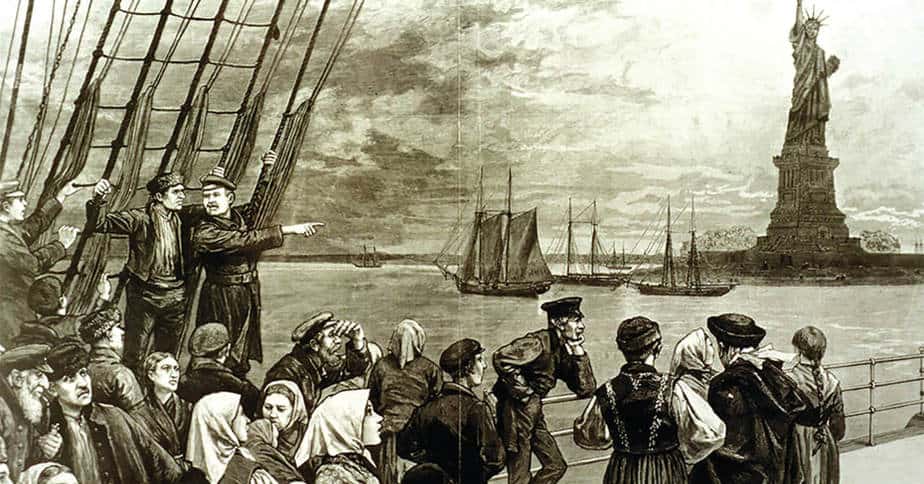Even the original Puritans who landed on American shores in the pilgrim ship were illegal aliens. So were Bengali Muslims in Harlem. So who’s legit?
In the much-talked-about documentary series, Wild Wild Country (Netflix), about Osho Rajneesh, Maa Anand Sheela makes a statement about those hell-bent on stopping them from setting up their commune as bigots suffering from a “religious prejudice as well as a Mayflower mentality—I came here before you, therefore, you can’t be here.”
The Mayflower was the original English ship that transported the first 102 Puritans, known today as the Pilgrims, from Plymouth, England, to the “New World” in 1620. These were the original “illegal aliens” to arrive on the continent of North America. Not long after, the indigenous occupants of this land were decimated, and, in little more than a century, the United States Declaration of Independence was drafted and the Caucasians laid claim to the land by their own decree. With slaves at their disposal, they profited and carved a nation unlike any other, whose riches and promises are still being enjoyed by most of their descendants.
Once the Union was formed, legal immigration was more or less restricted to people coming from Western Europe. Even though the Chinese came at the turn of the 19th century, mostly as labourers to build the transatlantic railroad, they were discriminated against and used mostly as indentured servants.
So hostile was the opposition to the Chinese immigrants that, in 1882, the US Congress passed the Chinese Exclusion Act, prohibiting immigration from China for the next 10 years. The Chinese Exclusion Act was the only US law ever to openly prevent immigration based on race.
I just started work on a film that tells the story of a young Indian man who stowed away onto a British colonial steamship and made the perilous journey to New York in the 1920s. To his surprise, he found an enclave of Bengali Muslims in Harlem that helped him cope with this strange land. In the extensively researched book Bengali Harlem and the Lost Histories of South Asian America, Vivek Bald (also the director of the film) brilliantly unearths the lost stories of a group which played a part in building America from the shadows.
As “illegal aliens”, many of them lived in hiding, working as dishwashers and menial labourers. Disconnected from their families back home, they started new lives marrying into Puerto Rican and African American communities, while trying to hold on to their roots. The Bengalis of Harlem were the earliest trailblazers from a part of the world that later went on to build Silicon Valley and form the affluent South Asian American community that we know of today.
Prior to 1965, policies such as the National Origins Formula limited immigration opportunities from areas outside Western Europe. The goal was to prevent immigration from changing the ethnic distribution of the population. The Immigration and Nationality Act of 1965 abolished that formula, replacing the system with quotas for the Western and Eastern hemispheres. This dramatically altered the ethnic make-up of the country, bringing us to the present character of America, where diversity, for the most part, is seen as an asset and not an anathema.
Immigration has always been and always will be a controversial topic of discussion in this nation, around which positions are taken and the future of elections and leaders are decided. Some who have been here for long, see it as a threat. Those who have come recently want more of their tribe to join the party. Then there are those who acknowledge the history of its foundation and celebrate the inevitability of it. Some out of guilt and others out of compassion.
The ascent of Barack Obama to the presidency was a rare moment in American history when people thought a rung had been climbed in this regard. Even though deportation of illegal immigrants was the highest in decades under his presidency, the general sense was that he was pro-immigration and humane in his approach towards groups who in the past were considered pariah.
But when Donald Trump rose to power in a backlash to the eight years of a fairly liberal approach, a hard line was adopted quickly, attempting to take us right back to the 1960s. The vision of a towering concrete wall along the southern border became popular with many. A complete ban on immigration from certain Muslim nations was seen as a solution to terrorism. The children of illegal immigrants who were sheltered by the previous administration were now told that their protections would be taken away. And the spouses of guest workers mostly servicing Silicon Valley, who had gained the privilege of being able to work and contribute to the economy under President Obama, were now told to stay home. In essence, immigration from non-European nations was tightened like never before, and groups that could gain a place in American society were being told they don’t belong here.
According to current trends, by 2050 the demographics of this nation will be irreversibly altered. The Hispanic population will become the majority. For the first time in the history of this nation, the census will clearly show that the race that landed on the Mayflower will no longer be in predominance. For most people around the world, by default, the word “American” conjures up an image of a white person. That will have to change in the future by design. And it is this fear that drives the rhetoric that you hear coming from the current President’s mind and mouth. It galvanises a significant population bringing their inherent racism to the surface.
The demographic shift might bring some diversity to Congress and its leadership. It is inevitable. But, in reality, the change is only going to be along the margins. The current Congress and Senate are far from accurately representing the demographic make-up of America. It is not going to shift anytime soon. In a capitalistic system, those who wield economic power always define who governs.
But what will have to change is the Mayflower-mentality that people harbour — the notion that I came before you, therefore I have more sway over this land has no credibility. The day a wall can stop someone from coming here will be the day the notion of America will cease to exist. That notion is presently being put to the test as a caravan of asylum seekers, fleeing violence in central America, amass at a border fence in Tijuana, Mexico.
A mere 556 people from the entire human race, since the dawn of human time, have travelled to space to watch the sun rise and set over a curved horizon. Just 24 saw the earth shrink in the distance until it was no bigger than a coin. And only six have seen it completely disappear on the far side of the moon. For many who have seen the earth from above, it is the majesty of all the life it harbours that has left them in reverence and wonder. The next thing that struck them is the absence of borders.
This article was originally published in Newslaundry





